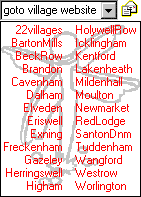





| |
In Memory of the men of
Herringswell who gave their lives in the Second World War
Manís
inhumanity to man makes countless thousands mourn.
In Memory of
GEORGE DOUGLAS ARCHIBALD HORREX
Private
6028234
2nd Bn., Essex Regiment
who died on
Friday, 12th June 1942. Age 29.
|
Additional Information:
|
Son of Archibald Thomas Horrex, and of Grace
Sarah Horrex, of Herringswell, Suffolk.
|
Commemorative Information
|
Cemetery:
|
DELHI WAR CEMETERY, India
|
|
Grave Reference/
Panel Number:
|
5. L. 11.
|
|
Location:
|
Delhi War Cemetery is
about 11 kilometres from New Delhi, on the eastern outskirts of Delhi
Cantonment and occupies a flat rectangular site adjoining the existing
cantonment cemetery. Proceed to Delhi Cantonment via Sardar Patel Road
to Dhaula Kuan roundabout, then continue along the ring road to Brar
Square, over the level crossing, then continue for 1 kilometre along
Cemetery Road, the cemetery is on the right hand side. The first
Commonwealth War Graves Commission direction sign is on the Dhaula
Kuan roundabout and the second on Brar Square just before the railway
crossing. The Cemetery has an imposing entrance of Grey Dholpur Stone,
within which is one part of the Dual Memorial to 25,000 men of the
Army and Air Force of Undivided India who died during the 1939-45 War
while on service in non-operational zones - the Delhi and Karachi
1939-1945 War Memorials. Also within the Cemetery, located inside the
entrance feature on the left-hand side, is the Delhi 1914-1918 War
Memorial commemorating those 1914-1918 War Dead buried in Meerut
Cantonment Cemetery whose graves were classified as unmaintainable.
The Delhi Cremation Memorial, within the Cemetery next to the Special
Memorial erected to Private Mackie, commemorates a member of the
W.A.A.F. who was cremated at New Delhi. The ashes were deposited in
St. Martin's Church, Delhi, but cannot now be traced by the Church
authorities.
|
|
Historical Information:
|
Delhi, the ancient capital of the Mogul Empire,
is the capital of the Republic of India. The old city, begun in 1638
by the Emperor Shah Jehan, is a closely built walled city on the
western bank of the river Jumna, with many ancient buildings. The new
city, built when the capital was transferred from Calcutta to Delhi,
is on a rocky platform on the slopes of the hills south of
"old" Delhi. The War Cemetery is about 11 kilometres from
New Delhi on the eastern outskirts of Delhi Cantonment, and occupies a
flat rectangular site adjoining the existing cantonment cemetery. It
has an imposing entrance of grey Dholphur stone within which is one
part of a dual Memorial to men of the army and air force of Undivided
India who died during the 1939-1945 War while on service in
non-operational zones. The cemetery also contains the graves of 1022
1939-1945 War Dead. In 1966, ninety-nine War Dead of the First World
War were transferred from Nicholson Cemetery, Kashmir Gate, Delhi to
Delhi War Cemetery, where the graves could be cared for in perpetuity.
One of the 1914/1918 War Dead remains in Nicholson Cemetery and is
commemorated by a special memorial in Delhi War Cemetery. Marked by a
Private Memorial of Brigadier-General Jennings also contains his wife.
|
In Memory of
MOSTYN LLEWELLYN DAVIES DSO
Major
230270
General List
who died on
Saturday, 25th March 1944. Age 33.
Church plaque states missing 22nd
March 1944 at Crna Trava, Bulgaria whilst performing outstanding services in
enemy occupied territory which gained him an immediate award of the DSO.
|
Additional Information:
|
Son of Llewellyn Sydney and Clara Lina Andrea
Davies; husband of Brenda Margaret Davies M.A. Charted Accountant,
Actuary.
|
Commemorative Information
|
Cemetery:
|
BELGRADE WAR CEMETERY, Yugoslavia
|
|
Grave Reference/
Panel Number:
|
Joint Grave. 9A. D. 7-8.
|
|
Location:
|
The war cemetery is
in Uliga Baju Sekulica, in the city's Fifth Region, and is on the edge
of the New Yugoslav Cemetery (Novo Groblije).
|
|
Historical Information:
|
The cemetery was created to receive the remains
of British and Commonwealth casualties brought in from more than sixty
small burial grounds and from isolated sites all over Yugoslavia. The
largest number from any one place came from Milna Military Cemetery
and the Royal Naval and Harbour Cemeteries on the island of Vis (Lissa)
which was our base. The burials in the War Cemetery include escaped
prisoners of war from Italy and Greece. The civilians buried here
include a mining technician, a teacher of English, a newpaper
correspondent, a member of the Embassy staff and the child of another
member of Embassy staff. They were buried or re-buried in the cemetery
by permission of the Army Graves Service.
|
|